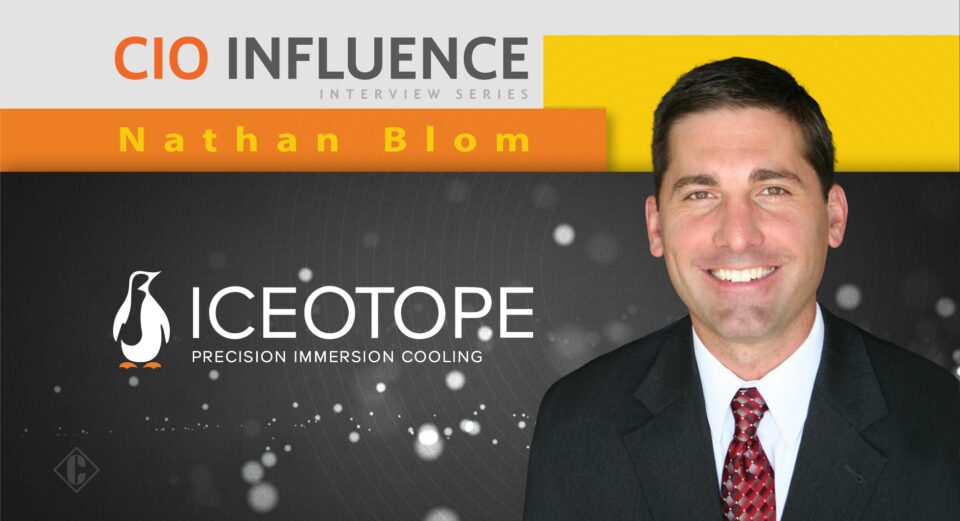“Edge computing requires data storage solutions that can handle large amounts of data while being both cost-effective and energy-efficient.”
Hi, Nathan, welcome to our Interview Series. Please tell us a little bit about your role and responsibilities at Iceotope. How did you arrive at the company?
As Chief Commercial Officer at Iceotope, I am responsible for all elements of the company that connect with external stakeholders, specifically customers, technology alliances, channel partners, integration partners, and other strategic alliances. I most recently was at Lenovo for seven years working in OEM, global sales and marketing, and strategy and transformation. Previous to that I was at HP where I managed teams serving the SMB market and OEM communities across the Americas, including Latin America and Canada.
In my work at Lenovo I was exposed to Iceotope’s technology and became very interested in understanding the implications of precision liquid cooling as a way to meaningfully reduce an organization’s carbon footprint in their drive towards Net Zero. The more I learned about Iceotope’s technology, the more enthusiastic I became in supporting the adoption of this revolutionary approach to cooling. When the opportunity emerged for me to join the company earlier this year, I jumped at the chance to join this incredible team.
What is Iceotope? What are your core offerings?
Iceotope Technologies is redefining cooling for the IT stack accelerating a sustainable digital world. Be it in a data center facility or an edge location like a hospital, bank or retail store, we deliver game-changing precision liquid cooling solutions to make it easier for our customers to achieve their Net Zero targets.
At our core we are an engineering company. We listen to our customers, paying close attention to their needs, so we can help them achieve their business goals faster and more efficiently. Early on, we recognized that nearly half of the electricity consumed for IT processes was for cooling so that CPUs, GPUs, memory, drives and power supplies could function within thermal specifications. This is a highly inefficient way to provide compute to individuals and businesses.
Iceotope’s solution is a simple solution that operates using the same architecture as air cooled systems while eliminating energy wasted on cooling and maintaining simple serviceability and scalability. Iceotope is able to partner with server manufacturers to design new hardware, transform existing hardware to gain the benefits of our technology, or create custom builds for hyperscalers, high performance computing (HPC) customers or other large enterprises.
Read More: CIO Influence Interview with Kimberly Wood, Chief Information Officer at Guardsquare
Data storage technologies are evolving with Edge, GPUs, and HPC capabilities. Could you please highlight some of the key trends in the data storage industry?
As every company globally becomes more focused on the drive toward sustainability, reducing energy consumption for data storage will become an important component in the equation toward Net Zero carbon footprint. Overall, the trends we’re seeing in the data storage industry reflect the growing demand for faster, more efficient, and more scalable storage solutions to handle the growing volume and variety of data created each day.
Data processing at the edge of the network, closer to the source of the data, instead of sending it to a centralized data center, has emerged as a popular trend as IoT devices and the need for real-time data processing increase. Edge computing requires data storage solutions that can handle large amounts of data while being both cost-effective and energy-efficient. As AI, machine learning, and data analytics become more compute-intensive, GPUs are increasingly being used. As such, data storage solutions are being designed to take advantage of the processing power of GPUs for faster data processing and analysis. Additionally, high-performance computing (HPC) has become increasingly important for applications including scientific research, weather forecasting, and financial modeling. This requires data storage solutions that can handle massive amounts of data while delivering high bandwidth and low latency.
All of these trends have one thing in common – they are all pushing the boundaries of cooling technology. Across all locations, conventional air-cooling methods can no longer meet the requirements of high-power, high-density server loads. Solutions like precision liquid cooling offer a more sustainable, scalable and serviceable approach for reliable operations of data storage.
What is Precision Liquid Cooling technology? How does it improve data center performance?
As the name implies, precision liquid cooling is a patented technology that cools, protects and monitors the whole IT stack in any location from the extreme edge to the hyperscale cloud. Small volumes of a dielectric compound circulate across the surface of the server to the hottest components first, removing nearly 100% of the heat generated by the electronic components. Offering up to 40% power reduction and 90% water reduction per kW of ITE, precision liquid cooling is changing the design, build and operations of data centers.
Precision liquid cooling reduces energy consumption, extends component lifecycles, maximizes higher density compute in space saving environments, and reduces noise output. The entire ecosystem can operate at peak capacity without throttling or experiencing any degradation of performance. In fact, we’ve seen increases in total system performance by 5% to 7% as well as a 30% total data center energy savings. By providing simple serviceability, increased density, and a scalable solution, the total cost of ownership for a data center provider of any size is dramatically decreased.
How do you position Iceotope in the era of AI and supercomputing with your precision liquid cooling technology?
Iceotope offers cooling solutions optimized for high-performance computing workloads and can help organizations achieve breakthrough results in their sustainability initiatives. Artificial Intelligence (AI) and supercomputing are the tip of the spear when it comes to needing advanced cooling solutions to power the highest capacity CPUs and GPUs in dense configurations. Because Iceotope’s technology is able to precisely cool each of these components, regardless of where they sit within the chassis in relation to one another, we can maximize performance of each system to generate the maximum ROI within the total environment.
Read More: CIO Influence Interview with Logan Welley, Vice President of Alliances at Fivetran
Please tell us more about your recent collaboration with HPE, nVent, and Intel. Where are we heading with data Net Zero Efforts for Open RAN solutions?
Net Zero efforts for Open RAN solutions are aimed at reducing the carbon footprint of telecommunications networks by improving energy efficiency and reducing energy consumption. As Open RAN becomes the standard in the Telco industry, it is imperative to develop and deploy solutions that minimize the amount of electricity required to power devices on the edge.
Partnering with HPE, Intel, and nVent, Iceotope has developed an Open RAN solution to significantly reduce energy consumption and deliver a sustainable solution across distributed workloads, for both telco service providers and enterprises. The solution, Ku:l Extreme, is a highly efficient and truly scalable Open RAN solution to support Far Edge computing across the entire telco data center estate. It not only mitigates power constraints, but perhaps most importantly, simplifies and significantly drives down maintenance costs with extended server lifecycles, reduced failures, and Out of Band Management (OOBM) remote management.
What are key metrics that CIOs should evaluate while building a converged CPU/GPU architecture with AI/HPC workloads? What kind of support and resources do you provide to your customers?
Power usage effectiveness (PUE) has long been a data center industry metric to gauge how efficiently a data center uses energy. While it is a well established and widely accepted metric, we are beginning to see other metrics come into play to get a more holistic view of data center efficiency.
One such metric is pPUE, partial or cooling power usage effectiveness. pPUE is a more granular metric that enables a data center operator to define a portion of the overall PUE within a defined boundary. In the case of servers, pPUE speaks to the energy efficiency, or energy spend, required to deliver the server compute solution. It effectively allows one to calculate performance/watt inclusive of server and data center infrastructure.
We are likely to see more implementation of pPUE as well as water usage effectiveness (WUE) and carbon usage effectiveness (CUE) as we start to look at data center efficiency in the most sustainable way.
What advice would you offer to CIOs and CISOs looking to optimize their data and workloads in Cloud using platforms like Iceotope Ku:I Extreme?
At a time when sustainability is driving business decisions, technology can offer us a path forward to meet the demands of the current climate challenges. That is going to require the courage to lead and the willingness to embrace change for the greater good.
When it comes to data center cooling, air cooling is fast reaching its limitations. The willingness to depart from the air-cooling paradigm has the potential to give rise to the greatest benefits. Moving away from a well-known technology solution can be daunting, but now is not the time for incrementalism. CIOs should be incentivizing their team to focus on sustainable solutions that deliver rewards for tomorrow and not just focus on today’s CAPEX spend. There is a real competitive advantage opportunity for companies willing to adopt new technologies and find a new way to do business.
Read More: CIO Influence Interview with Andrew Hollister, Chief Information Security Officer at LogRhythm
Thank you, Nathan! That was fun and we hope to see you back on cioinfluence.com soon.
[To participate in our interview series, please write to us at sghosh@martechseries.com]
Nathan Blom is the Chief Commercial Officer at Iceotope Technologies, Ltd. Blom leads the company’s strategy for sales growth, expansion of its market strategy with channel partners, ongoing transformation of marketing functions, and to increase the value of strategic partnerships within the IT and data centre infrastructure markets. Blom comes to Iceotope from Lenovo, where he led strategy and transformation for North America ISG (Infrastructure Solutions Group). He began his career in IT at HP in 2009, where he managed teams serving the U.S. SMB market and OEM communities across the Americas, including Latin America and Canada.
Iceotope’s chassis level precision immersion cooling solutions are engineered to cool the whole IT stack, in every use case, from Hyperscale to the Extreme Edge. By removing the need for fans and air-cooling infrastructure, Iceotope’s technologies operate in near silence — bringing game-changing reduction in energy and water consumption, and significant cost reductions in the design, build and operation of data centers.



